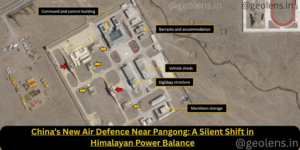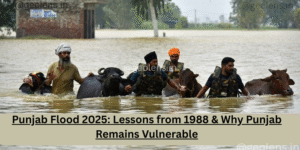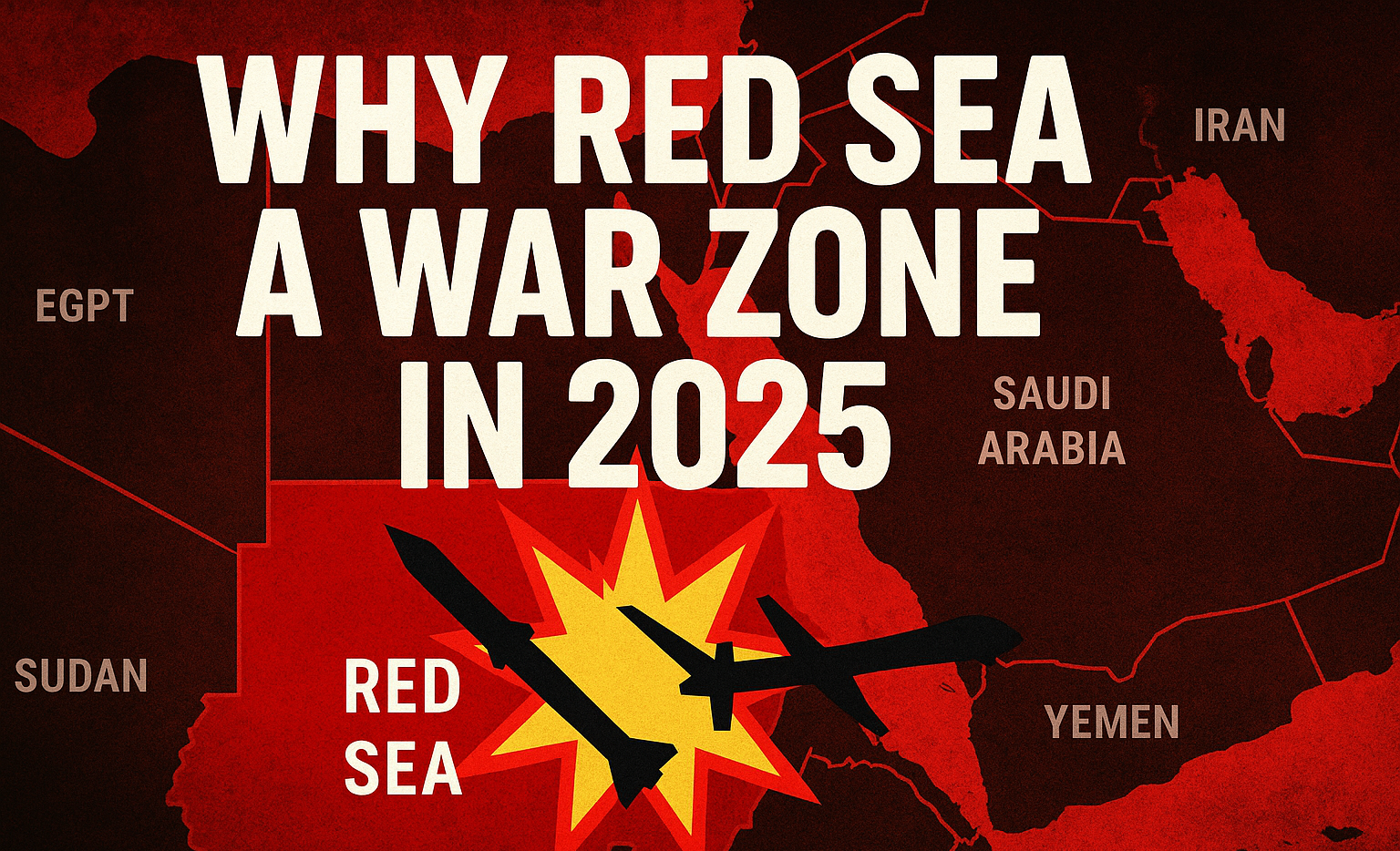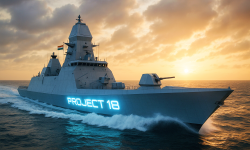Table of Contents
A few more months are left in 2025, Yet conflicts around the world are taking shape, and one of the hotspots “The Red Sea” now a day isn’t just a tourist place- it’s a battlefield from drone strike to ship attack, the sea is under heavy pressure from the west and from the rest of the world. But why?
Who’s fighting? And what’s at stake for the world and most importantly for India
Let’s find out and decode “Erythraean Sea”
What is Red Sea, Why it is called Red Sea, location & it's importance
The Red Sea is a seawater inlet for the Indian Ocean, located Between the middle east and African plate. It’s one of the major trade route helping in connection entire Aisa to the Europe via Suez Canal, Which holds tremendous geopolitical and strategic importance.
The Red Sea is likely named for the seasonal blooms of a type of cyanobacteria called Trichodesmium erythraeum, which can turn the normally blue-green water a reddish-brown color.
Alternatively, some believe the name comes from the way colors were used to represent directions in ancient Asiatic languages, with “red” potentially signifying “south”.
The total length of the red sea is roughly 438,000 km2 (169,000 sq mi), that is about 2,250 km (1,400 mi) long, and 355 km (221 mi) wide at its widest point
With the counties surrounding to it are: Saudi Arabia and Yemen to the east, and Egypt, Sudan, Eritrea, and Djibouti to the west. Additionally, Israel and Jordan have coastlines on the Gulf of Aqaba, an extension of the Red Sea. Which at the ends connected to the Suez Canal.
Additionally, 12-15% of the global trade passes here, it is a vital route for trade like oil, gas, and other essential goods, and interruption here can have significant repercussion for international trade and the global economy.
Think of Red Sea as a highway between Asia and Europe for Cargo ships. If it’s blocked, the entire world will pay
What happened? Timeline of the conflict (2023 to 2025)
Back in 2023 the Rea Sea witnessed heavy attack on the commercial cargos & vessels by the Yemeni’s Houthis rebel group. Followed by the Israel-Hamas war. The attack not only limited to missile and drones, which disturb the global trade route, but also economical, which leads to increasing shipping cost and delays.
Houthi Attacks: The Houthis, who Dominated much of Yemen, started targeting vessels in the Red Sea in solidarity to Palestinians in Gaza, which was under Israel’s siege. Disrupted the trade route that handles About $1 trillion Goods annually.
Outbreak: The attack escalated after the initial ceasefire between Israel and Hamas in Gaza, with the US and its allies’ launching strikes against the Houthis. Attacked and seized several ships, including the Galaxy Leader, and sunk at least two vessels.
Retaliation: US and its allies responded with airstrikes targeting Houthi sites in Yemen. Despite a ceasefire agreement in May, the Houthis have continued occasional missile attacks targeting Israel, and the situation remains volatile.
March 2024, the Houthis attacked more than 60 vessels in the Red Sea. To avoid attack, hundreds of commercial vessels have been rerouted to sail around South Africa. Which technically increased shipment cost and delivery time. The Houthis’ Red Sea attacks have drawn a military response from a number of countries.
And now coming to 2025: A Liberian-flagged cargo ship came under heavy fire on Monday (July 6, 2025) in the Red Sea, with two security guards on board hurt and two others missing in an assault that came after Yemen’s Houthi rebels purportedly sunk another vessel in a similar attack.
Who are the main players involved?
Houthis (Yemen Rebel group) 🇾🇪
Iran 🇮🇷
USA 🇺🇸
Israel 🇮🇱
India 🇮🇳
Saudi Arabia 🇸🇦
Military Group Attacking Ships
Allegedly supports Houthis
Protecting trade route, retaliation
Involved due to Gaza tension.
protecting Indian ship via Navy
wants peace under pressure
Why this conflict matters to the world ?
1. Fuel Prices Will Skyrocket
A huge amount of the world’s oil and gas is shipped through the Red Sea, especially from the Middle East to Europe and Asia.
If the Red Sea is blocked, ships carrying oil will be forced to take longer routes, burning more fuel and taking more time.
This means less supply of oil in the market and higher prices at petrol pumps in countries like India, USA, UK, and others.
2. Shipments Will Take Longer to Deliver
The Red Sea is one of the world’s busiest shipping lanes, like a shortcut between Europe and Asia.
If it’s unsafe or blocked due to war, ships will avoid it and use the longer Cape of Good Hope route around Africa.
This adds thousands of extra kilometers, meaning:
1.More fuel usage
2.More delay in deliveries
3.Higher costs for shipping
“Your Amazon delivery or imported goods (like electronics, clothes, or food items) may take longer and cost more.”
3. Risk of a Bigger Middle East War
Countries involved in the Red Sea conflict (like Israel, Iran, Yemen/Houthis) are already part of a tense region.
If fighting spreads, more countries might get involved, possibly leading to a full-scale regional war. That would destabilize oil markets, force millions to flee, and create global political tension (like what happened in Ukraine-Russia war).
4. Economic Slowdown
5. Global Supply Chain Gets Affected
The supply chain is how products move from factories to your hands — through ships, trucks, ports, etc.
Blocking the Red Sea breaks this chain, especially for products from:
China, Japan, India (going to Europe) Or European goods (coming to Asia)
This affects:
Cars, electronics, medicines, even food items.
Factories may stop working if raw materials are delayed. Prices go up due to less availability.
Also read about – India’s Project 18 Destroyer: Armed with 144 Missiles including BrahMos with Surveillance Power up to 500 km
India's crucial role in red sea conflict
1. INS Visakhapatnam Escorting Ships
The INS Visakhapatnam is one of India’s most powerful and modern destroyer warships. Due to rising attacks by Houthi rebels on merchant ships in the Red Sea, India deployed this warship to protect Indian cargo vessels. The mission: Escort Indian-flagged ships safely through dangerous waters.
This shows India’s commitment to protecting its citizens and trade, even in international waters. And Why it’s important: Without protection, Indian ships might get attacked or delayed, which would harm India’s economy and reputation in global trade.
2. Indian Navy’s Operation Sankalp
If we drop down in June 2019 when Bharat launched Operation Sankalp which means (resolution) after tensions rose in the Gulf and Red Sea. Under this operation, the Indian Navy deployed multiple warships and surveillance aircraft to ensure the safety of Indian ships and crew.
Why it’s important:
3. Why the Red Sea Matters to India's Energy and Trade
What Happens Next: Future Possibilities in the Red Sea Conflict
1. Escalation: Wider Proxy War
-
More frequent ship attacks
-
Direct US-Iran confrontation
-
More Western naval presence, increasing tensions
This could pull in regional players like Saudi Arabia, UAE, and Israel, turning it into a bigger Middle East war.
2. Possible Peace Talks – But with Conditions
3. Global Economic Impact Continues
If the conflict drags on, we’ll see: Continued oil price volatility, Disruption of global trade (especially Europe–Asia). Possible re-routing of global supply chains. Countries like India, China, and even African nations will suffer in the long run due to longer shipping times and higher costs.
In My View, The Red Sea is now a battlefield of global influence: US vs Iran, with innocent trade routes caught in between. If diplomacy fails, this could turn into another long-term cold conflict — like the South China Sea.
However, if neutral powers (like India, Turkey, Qatar, and the UN) step in and push for maritime peace and Gaza ceasefire, there’s a chance for de-escalation by late 2025.
Conclusion: why you should care
“The Red Sea may feel far away, but its waves reach our wallets, fuel tanks, and future. Understanding it today could mean preparing for the world of tomorrow.”
Quick Recap (Bullet Points)
1. Red Sea connects Asia to Europe
2. Conflict driven by Houthi rebels, Iran, US
3. Global trade and oil prices affected
4. India is involved via Navy patrols
5. Conflict could expand or cool down
What do you think — Will the Red Sea be the next war front like Ukraine or Iran? Let me know in the comments
“No” Third Aircraft Carrier: What It Means for the Future Indian Navy
|The GeoLens – Indian Defense & Global Affairs

Pratik Kondawale
Strategist | Indian Defence & Global Affairs
Founder of GeoLens.in, Pratik writes in-depth analysis on India’s defence strategy, military tech, and global power shifts delivering sharp insights through an Indian lens.

Tejas Crash at Dubai Air Show 2025 — A Tragedy, A Lesson, and A Call for Reform
The Tejas crash at the Dubai Air Show turned a moment of national pride into sudden heartbreak when Wing Commander Syal lost his life. This article unpacks the events of that day, explains why the Tejas crash matters for India’s defense readiness, and outlines the practical lessons and reforms needed to ensure the program recovers stronger. It also honors the pilot’s sacrifice and shows how the Tejas crash can become a catalyst for accountability, safer engineering, and faster delivery of operational jets.

Bangladesh EX-PM Sheikh Hasina Death Sentenced: Turmoil in Bangladesh and Rewired South Asian Politics
The Sheikh Hasina death sentenced verdict has detonated one of the most explosive political crises in Bangladesh’s modern history. Delivered in absentia by the International Crimes Tribunal, the ruling blames the former prime minister for orchestrating widespread state violence during the 2024 student protests. The decision has dismantled the Awami League’s long-standing dominance, pushed Bangladesh into a volatile power vacuum, and placed India in the middle of a diplomatic standoff. As questions about justice, political motivation, and regional stability collide, the fallout of this verdict is reshaping South Asian geopolitics in real time.

China with New Air Defence Near Pangong: A Silent Shift in Himalayan Power Balance
China’s new air defence near Pangong marks a major strategic escalation in the Himalayas. Satellite imagery reveals advanced HQ-9 missile systems, radar units, and fortified shelters aimed at asserting Chinese air dominance over eastern Ladakh. This development not only alters the regional military balance but also raises critical questions about India’s preparedness, response strategy, and the long-term implications for border security and geopolitical stability in South Asia.

Afghanistan Pakistan War 2025: Causes, Escalation, and India’s Strategic Advantage
The recent Afghanistan Pakistan war marks a dangerous escalation from border tensions to open state-level confrontation. What began with Pakistani airstrikes inside Afghan territory quickly spiraled into fierce Afghan retaliation, signaling Kabul’s newfound military assertiveness. This conflict exposes Pakistan’s growing vulnerabilities—diplomatic isolation, two-front pressure, and internal instability—while reshaping regional power equations.
For India, the turmoil presents both strategic opportunity and cautious optimism. A distracted Pakistan allows New Delhi to strengthen its influence in Afghanistan and consolidate regional partnerships. Meanwhile, the muted response from Gulf powers like Saudi Arabia and Qatar underscores Islamabad’s weakening alliances. As the Durand Line dispute reignites and media warfare intensifies, the Afghanistan Pakistan war stands as a defining moment in South Asia’s evolving geopolitical order—one that could tilt the balance of power in India’s favor.

Gen Z Protests in Nepal: From Nepo Kids, Corruption, Social Media Ban to Western Interference—What It Means for India
The Gen Z Protests in Nepal go beyond anger over a social media ban—they represent decades of frustration with corruption, nepotism, unemployment, and poor governance. Fueled by rising inflation, scams, and lack of opportunities, Nepal’s youth have taken to the streets demanding accountability.
But behind the scenes, questions of Western interference and U.S. attempts to reshape the world order add a deeper geopolitical layer. For India, Nepal’s instability is more than a neighbor’s problem—it carries direct implications for security, migration, and regional power balance.

Punjab Flood 2025: Lessons from 1988 & Why Punjab Remains Vulnerable
Punjab Flood 2025 has left a devastating mark across the state, with 1,400 villages submerged, 350,000 people affected, and 149,000 hectares of farmland under water. As rivers overflowed and dams released excess water, the disaster exposed Punjab’s recurring flood challenges and the urgent need for long-term resilience.


as soon as I discovered this site I went on reddit to share some of the love with them.
Howdy! This is my first visit to your blog! We are a collection of volunteers and starting a new project in a community in the same niche. Your blog provided us useful information to work on. You have done a wonderful job!